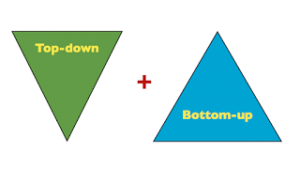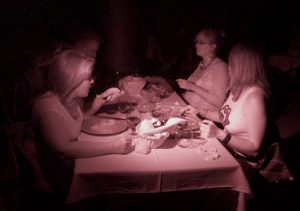
Anyone else remember the Shrek ketchup that used to line the supermarket condiments aisles when we were younger? It outmatched the ordinary Heinz bottles with a flashy label that advertised the product in “Blastin’ Green” and “Funky Purple.” Unfortunately, I still do. I think I actually pleaded with my mother to buy the novelty table sauce. Then my brothers and I eagerly, then regrettably, squeezed the bottle over a plate and stood in awe of the bright purple and definitely-not-what-ketchup-should-look-like-blob before us. Long story short, the ketchup went to waste. Still, besides the color, there really was absolutely nothing wrong with it. It was completely edible and tasted exactly like normal ketchup. So then why was it so hard to enjoy an order of Mickey D’s fries with a side of purple Shrek sauce?
Your Eyes Are Bigger Than Your Stomach AND Your Brain
I’m sure you’ve heard the saying, “Your eyes are bigger than your stomach.” It’s usually said, and is most applicable, during Thanksgiving, when your eyes say “yes” but your stomach says “no.” Though you may be physically unable to fit one more of your grandma’s homemade delicacies into your mouth, this doesn’t stop your eyes from constantly evaluating what is before you. But in the case of the Shrek ketchup, my brothers’ and my eyes were definitely saying “NO,” even though we were still hungry.
This is a case of what neuroscientists call “bottom-up processing” getting in the way of “top-down knowledge.” “Bottom-up processing” is what describes the external to internal direction in which information about a stimulus is taken in by your brain. “Top-down knowledge” is similar, but the opposite of “bottom-up processing.” It encompasses all of what we already know about something and helps us make judgment calls.

For example, when you read the description of an entrée at a restaurant, even if you have never eaten that dish, your previous knowledge of the familiar flavors that constitute it allows you to imagine the meal as a whole. This is also the case for visual information. So while we all know that the “Funky Purple” Shrek ketchup was just ketchup, its outward appearance was novel and contradicted our “top-down knowledge” of what ketchup should look like.
Pulling Back the Color Curtain
In 2015, researchers from the Crossmodal Research Laboratory at Oxford University studied the color-expectation relationship in depth by reviewing a pool of experiments done on the color of food. Here are a couple of them:
In 2007, a scientist named Zampini ran a study that involved four flavors of drinks: orange, lime, strawberry, or flavorless. The drinks were presented as either colorless, or artificially colored red, green, or orange, with coloring added at standard or double concentrations. Participants then had to try and identify the flavor of their given drink and rate its intensity of flavor.
While the concentration of color had no effect on the perceived intensity, flavor identification was another story. Colored or not, flavorless drinks were easily identified, but when given a bright orange lime-flavored drink, only about 30% could correctly discern the flavor. Also, less than 50% could tell the flavor of a colorless strawberry drink.
Here’s another experiment that’s slightly more insidious. Ever try smoked salmon ice-cream? That’s okay, neither did these next participants…until Martin Yeomans and his colleagues from the University of Sussex decided to see what would happen if the meaning of color were misinterpreted. Not gonna lie, it’s pretty “cool.”

In this study, participants were split into groups and given pink ice cream. Group 1 was told nothing, Group 2 was told that they were trying a brand called “Food 386,” and Group 3 was told that they were going to have frozen savory mousse. Groups 2 and 3 enjoyed the fishy delight and even rated it higher than its fruity counterpart. Sadly for Group 1, who had presumed the frozen pink treat to taste like strawberry, the first bite was quite the shock. The stark contrast in expected flavor vs. reality even led to their perception of the dish as tasting overly salty, in contrast to Group 2 and 3, who rated it as perfectly seasoned. I have never been more thankful for menu descriptions.
If these experiments tell us anything, it’s that a lot of what we taste and expect to taste happens in our heads. Sometimes before the first bite! Perhaps it’s our brain’s way of helping us make decisions so that we don’t have to try every dining option at Price Center just to know what we’re in the mood to eat. Thanks, brain.
Or perhaps there’s another reason why the first (sort of) real bite is taken in the noggin. One that’s truly helped you along the way.
CAUTION (When Color is a Warning)
For this next explanation, let’s return to the question that started all of this. Why was I so turned off by purple ketchup? As we have learned from the experts in the makeup world, the best looks are natural. Purple flowers? Sure. Purple butterflies? Why not? Purple ketchup? Erm, no. Seriously.
One researcher, J Wheatley, really wanted to see the effects of unnatural food color in real-time. So, he invited guests to a dinner party for a meal of steak, chips, and peas. Though the dim lighting made it a little difficult to see, the general shapes of the food were still discernible so they promptly dug in. However, after some time, the lighting was returned to normal. To the guests’ horror, the steak was revealed to have been dyed blue, the chips dyed green, and the peas dyed red. Unsurprisingly, a number of people fell ill once the truth was revealed.
Like my purple ketchup, the color of the dinner guests’ meal was just off. Yet it makes sense that the color would yield such an adverse reaction. Whenever food isn’t the right color, it is probably because there is something wrong with it. Usually a color change is the result of food gone bad or mold growth. So, at Wheatley’s dinner party, the guests’ bodies made a last ditch effort to remove the potentially harmful food from their system, thereby making them sick.
The Age of ‘Neurogastronomy’

Restaurateurs today have seemingly caught on to the brain’s heavy reliance upon the visual system. Now, a new kind of dining experience is taking root in cities all over the globe: dark dining. Much like Zampini’s drink experiment, these lightless restaurants mystify patrons by removing all visual cues. In other words, zero expectations for the brain. Flavor takes on a whole new meaning, including some that become disconcertingly unidentifiable.
The first “dark dining” experience took place in Zurich’s blindekuh in 1999 and has led the way for the international chain Dans le Noir and more recently, the California-based Opaque (which has locations in San Francisco and Los Angeles, by the way).Before you grab your things though, it might be a good idea to prepare yourself by bringing some cash to burn, given the $$$$ on Yelp.
This age of “neurogastronomy,” albeit young, is changing the future of science and food as we know it. Dan Han, the chief neuropsychologist at the University of Kentucky, and Montreal chef, Fred Morin, have joined forces along with others in the culinary arts, food science, agriculture, and medical fields to form the International Society of Neurogastronomy. This group has set themselves on an ambitious path to “advance neurogastronomy as a craft, science, and health profession, to enhance quality of human life, and to generate and disseminate knowledge of brain-behavior relationships in the context of gastronomy.”

Since the group’s first meeting in November 2015, current research projects involve helping people who suffer from gustatory (tasting) and olfactory (smelling) deficits as a result of brain trauma, chemotherapy, and other central nervous system conditions. Knowing that the perception of flavor truly happens in the brain rather than in the mouth, neurogastronomists are working to identify which odor receptors are specifically activated by certain odor molecules. This could lead to the development of technologies that would work to enhance flavors for all who suffer from taste or smell loss. Who knows? Maybe such developments could even lead to a world in which broccoli is a kid’s best friend.
[hr gap=””]
References
- http://grist.org/food/neuroscience-comes-to-dinner-how-brain-tweaks-could-change-our-diet/
- http://link.springer.com/article/10.1186/s13411-015-0031-3
- http://travel.cnn.com/bangkok/eat/dark-dining-188185/
- http://www.newsweek.com/2016/05/06/neurogastronomy-taste-deprivation-smell-loss-palatable-food-452819.html